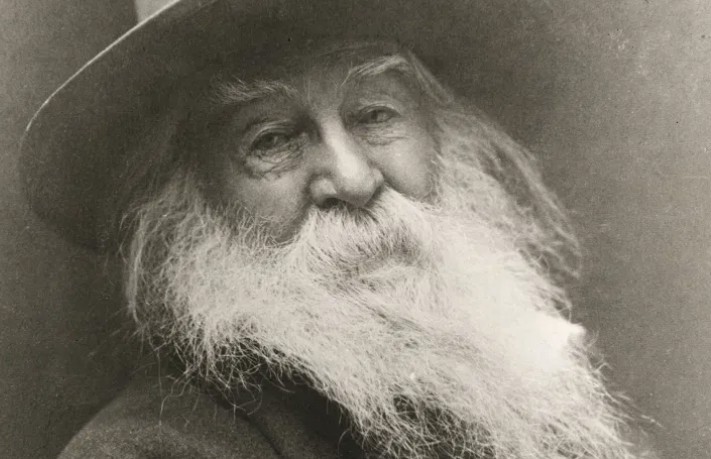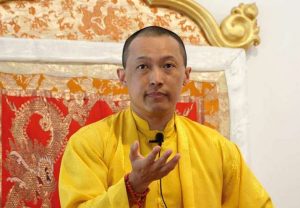
The Ryōan-ji rock garden in Kyoto is probably the most famous rock garden in the world. There are many reasons for this, but one is especially fascinating. Since it was first constructed in the mid-1400s, people have been puzzling over why there isn’t a single point in the entire garden where you can see all 15 of the stones. If you move from one spot to another, you can see a stone or two that you couldn’t see before, but no matter where you stand there’s always at least one that’s out of sight.
What does it mean, this physical metaphor, this visual koan?
Maybe that there’s always something in our blind spots that we can’t see at the moment? Maybe that when we’re stuck, we should consider whose perspective we need to adopt to see what’s missing from our current field of vision? Or maybe that we need to be in a different point in our lives to see something that is currently hidden from our awareness?
Maybe.
But mainly it seems to be a reminder that, as St. Francis of Assisi supposedly put it: “What we are looking for is what’s looking.” In other words, the stone that always remains unseeable seems to symbolize the invisible, impalpable vantage point from which we see. Put differently, the invisible stone prompts us to become aware of awareness itself. After all, what usually remains outside of our awareness is the point of view from which we are viewing: pure awareness, witness consciousness, the observing self, the seat of awareness, the transcendent self, big mind, wise mind, rigpa, ground of being, Christ consciousness, Buddha-nature.
In the Rinzai school of Zen Buddhism, which the Ryōan-ji rock garden is an expression of, there is a word for the experience of becoming aware of awareness: kenshō. Often used interchangeably with the word satori, kenshō means “seeing one’s true nature” or seeing the nature of mind.
This subtle but transformative experience is widely regarded as a turning point to awakening.
Waking up
Until he was 30, Eckhart Tolle says he lived in a state of almost continuous anxiety, interspersed with periods of suicidal depression. Then one night, not long after his 29th birthday, Tolle woke up in the early hours of the morning with an unbearable feeling of dread. His contempt for the world was surpassed only by his contempt for his own existence. The same thought kept repeating itself in his mind: “I cannot live with myself any longer.”
“Then suddenly,” he writes, “I became aware of what a peculiar thought it was. ‘Am I one or two? If I cannot live with myself, there must be two of me: the ‘I’ and the ‘self’ that ‘I’ cannot live with.” Maybe, he thought, only one of them was real. It took him another three years to understand that the intense pressure of suffering that night had forced his consciousness to withdraw from its identification with his unhappy and deeply fearful self. (Parker 2009, 101–2)

Similarly, when the prolific English author Colin Wilson was a teenager, he often experienced depressions so severe they would sometimes startle him awake in the middle of the night with horrifying visions of the utter meaninglessness of life. Eventually it became so bad that he decided to end his life. Wilson was working as a lab assistant at a night school and he knew there was potassium cyanide in the classroom where he worked. But when he got to the classroom, uncorked the bottle, and began raising it to his lips, he says: “I suddenly turned into two people. I don’t mean that literally, but I mean that there was I, and there beside me was this silly, bloody little idiot called Colin Wilson who was in a state of self-pity and about to kill himself, and I didn’t give a damn whether the fool killed himself or not. The trouble was, if he killed himself he’d kill me too.” And then, quite suddenly, he felt a sense of overwhelming happiness come over him. He corked up the bottle, put it back on the shelf, and for the next few days felt in complete control of his emotions and life. (Wilson)
Despite the intense suffering out of which they emerge, these sorts of sudden and seemingly one-and-done awakenings hold an obvious appeal, but it’s worth pointing out that Wilson’s experience wore off after a few days, and that it took Tolle nearly 10 years to integrate his. Gradual awakenings that are the result of many small awakenings, often experienced during formal meditation practice, seem to be much more common.
When he was 22 years old, for example, Michael Singer—who would later go on to write the bestselling books The Untethered Soul and The Surrender Experiment—was sitting on his living room couch in Gainesville, Florida, shooting the breeze with his brother-in-law Ronnie when an awkward silence opened up in their conversation. Singer had felt uncomfortable during silences like these before, but for some reason this time he noticed that he was uncomfortable. “For the first time in my life,” he writes, “my mind and emotions were something I was watching instead of being.” (Singer 2015, 8)
For a few moments Singer just sat there listening to the neurotic voice inside his head as it tried to “fix” the awkward silence. But the longer he observed it, the more he began to realize that he was not the neurotic voice but the one quietly watching it. “It was so obvious,” he writes, echoing both Tolle and Wilson. “I was in there watching my thoughts and emotions. I had always been in there watching, but I had been too unaware to notice. It was as though I had been so involved in their details that I never saw them as thoughts and emotions.” (Singer 2015, 19)
Unlike Tolle, the peace Singer discovered in this moment didn’t last happily ever after. Nor, like Wilson, did it subside after a few days. But after this subtle shift, Singer says, his life was never the same. Likening it to a tornado that rearranged his entire life, he says it led him on a passionate, lifelong quest to discover what the voice was, how he could quieten it and who he was when he was just watching the voice. A few months later, a classmate in his doctoral program handed him a copy of Philip Kapleau’s Three Pillars of Zen and he was both astonished and elated to find that there was a millennias-old tradition that provided answers to many of his questions. He began a formal meditation practice, bringing careful attention to the voice inside his head as well as the sense of self that can watch and train that voice.
The fine art of awakening
As the Ryōan-ji rock garden reminds us, the fine arts can also give us a glimpse of this elusive yet liberating sense of self. Near the beginning of his epic six-volume autobiographical novel My Struggle, Karl Ove Knausgård tells a poignant anecdote about a time when he was eight and his father utterly humiliated him. As he sits at night writing about the incident more than 30 years later, he catches a glimpse of his reflection in the window. Although his face looks sad and weary, his eyes still shine. This reminds him of Rembrandt’s final self-portrait, painted just months before he died in 1669.

Knausgård notes that although Rembrandt’s face is wrinkled and battered by time, his eyes remain bright and “somehow transcend the time that otherwise marks the face.” Then, sounding a lot like Tolle, Wilson, and Singer, he says: “It is as though someone else is looking at us, from somewhere inside the face, where everything is different.” This mysterious “someone else,” he feels sure, is none other than Rembrandt’s “very being.” (Knausgård 2013, 26)
And his description of Rembrandt’s “very being” is, again, quite similar to the other accounts we’ve seen. It is, Knausgård writes, “that which immersed itself in thought, but which itself was not thought, that which immediately immersed itself in feelings, but which itself was not feeling, and that which he went to sleep to, in the end for good. That which, in a human, time does not touch and whence the light in the eyes springs.” (Knausgård 2013, 32)
Here too there are two senses of self: embodied thoughts and feelings in time, and “someone else” inside, another “being” that “immerses” itself in thoughts and feelings and time, yet remains independent of them.
The Spanish poet Juan Ramón Jiménez expresses it like this:
I am not I.
I am this one
walking beside me whom I do not see,
whom at times I manage to visit,
and whom at other times I forget;
who remains calm and silent while I talk,
and forgives, gently, when I hate,
who walks where I am not,
who will remain standing when I die. (Jiménez 2003)
Jiménez, too, distinguishes between two senses of self, between one “I” and another. And the “I” he identifies with is clearly not the ordinary, everyday self we usually have in mind when we use the word “I”—the one who talks and hates and remains indoors—but “this one” who is invisible and disembodied and nonreactive.
Jiménez depicts this “I” as being accessible—in the sense that he at times manages to visit it—but only “at times” and even then only to “visit,” never as a permanent residence. And even these visits seem to require some effort; he only manages to visit it in the same way we sometimes manage to make it over to a friend’s house. Nevertheless, Jiménez clearly chooses to identify not with the everyday sense of self, which is verbal and reactive and mortal, but with the transcendent self, which is non-verbal, responsive and, in his view, immortal.
A secular account of the origins of the observing self
While both Knausgård and Jiménez speculate on the ostensible immortality of this transcendent sense of self, its existence can be accounted for in entirely secular terms, which means that we don’t have to be religious to reap the many benefits that come from accessing this sense of self.
Based on the roughly 300 studies that support Relational Frame Theory, a cutting-edge evidence-based psychological theory of human language, Steven C. Hayes contends that “the observing self emerges as a result of language use” (Hayes 2005, 94) and, more specifically, as “a side effect of language processes.” (85)
In a nutshell what Hayes means is that when we are first learning language we are taught to describe a multitude of different external and internal events from a consistent perspective. As very young children, each time we are asked a question about what we did or saw or ate or thought or felt, we are subtly rewarded for reporting our experience relative to a consistent, observational perspective. If we didn’t, our loved ones couldn’t get reliable answers to questions like: “What did you do at Sebastian’s?” Or, “Where did you put my muffin?” What remains consistent across the answers is not the content of our answers but the context, the perspective or locus, from which our answer are reported. This, according to relational frame theory, is what in the fullness of time leads to the formation of the observing self.
There are three linguistic classes of experiences that are especially critical to its formation: here/there, now/then, and I/you. The word “here” is often confusing to us when we are very little, at least initially, because it is not a specific geographical location like the high chair or grandma’s house; it is, instead, a constantly moving place from which observations are made. Similarly, “now” is not a specific time like naptime or bathtime; it is an always-changing time from which observations are being reported. Finally, “I” is not located in a fixed place or time; it is instead a vantage point from which observations are made in a multitude of different places and times.
In other words, each of these linguistic relations—here, now, and I—as well as their opposites—there, then, and you—only make sense relative to an observational perspective. And when these three classes of linguistic relations come together, a sense of perspective emerges as an integrated event, a consistent locus, a point of view or perspective from which experiencing occurs. (Hayes 2005, 85)
This observational perspective is unique, in part because it is experienced as timeless, placeless, and boundless. It transcends time because the person we call “I” was there when we were four, it was there last March, and it is here now as you are reading these words. In this sense, it not only transcends time (not literally but experientially), but it also transcends all the different roles we play throughout our lives. It also transcends place because although we are constantly moving around, no matter where we go, we are always seeing things from this perspective of “here.” Finally, it is boundless because we do not experience this “transcendent” self as a thing. As Hayes writes: “Almost every event we can describe is experienced as a thing: as an event with known boundaries. Yet here, right in the middle of verbal knowledge itself, is a ‘no-thing’ self.” (2005, 94)
Because this timeless, placeless, and boundless sense of self is formed as a natural by-product of language acquisition, it is always with us and it is always accessible. Because it is also the “place” from which we can be fully accepting, disidentified, present, valuing, and compassionate to both ourselves and others, an increasing number of contemporary psychological models (e.g. ACT, DBT, IFS, CRM, etc.) regard this sense of self as a key to psychological liberation. But it is also more than that; it doesn’t just help us heal, it also helps us awaken. It doesn’t just help us grow up, it also helps us wake up.
Waking out
Having said that, disidentifying from the ego, the small self, or everyday “I” (which looks from thoughts and feelings and sensations) and identifying with the observing self or the mindful witness (which looks at thoughts and feelings and sensations) is not the end of the line. In his Letters to a Young Poet, after Rainer Maria Rilke compares the vast expanses of the self to an enormous room, he observes that “most people come to know only one corner of their room, one spot near the window, one narrow strip on which they keep walking back and forth.” (Rilke 1986, 63) Shifting from the small self to a circumscribed observing self can be like taking a few strides away from the window, turning around and passively watching our small selves neurotically pacing back and forth on that narrow strip near the window.
And one of the dangers of stopping here is that we can find ourselves in what Loch Kelly calls “the witness protection program,” a state in which we remain identified with a dry or detached observing witness and try to live from a protected and disconnected stance, at arm’s length from our mind and body and other people. As Kelly writes: “If we live as the detached witness, we will be free of threat, but we will miss community and the juiciness of life.” (Kelly 2016, 170)
Similarly, Jack Kornfield observes that when we are caught in the grip of repetitive thought patterns, or stuck in painful situations, or find ourselves lost in a lot of physical or emotional suffering “even the witnessing can seem tedious, forced, effortful.” At such times, Kornfield recommends that we “open the lens of attention to its widest angle” and let our awareness shift from mindful witnessing “to become like space or the sky.” (“Big Sky Meditation”)

How do we do this? One simple way is to invite awareness to shift out of the vantage point of the mindful witness that observes thoughts and feelings and sensations, to the open space through which all of these thoughts and feelings and sensations are moving. This is what Siddhārtha Gautama recommends in the Majjhima Nikaya, when he encourages us to “develop a mind that is vast like space, where experiences both pleasant and unpleasant can appear and disappear without conflict, struggle, or harm. Rest in a mind like vast sky.”
Former UN secretary-general Kofi Annan tells an anecdote that captures the spirit of this subtle reorientation. When he was in high school, one of his teachers showed the class a big sheet of white paper with a small black dot in the corner. Then the teacher asked them what they all saw. (Gonzalez 2013)

All anyone noticed was the dot. Not one person mentioned the vast expanse of open space.
Shifting from mindful witnessing to spacious awareness is like this: rather than keeping our attention fixed on the black dot of thoughts, feelings, sensations, and images that may be troubling us, we simply shift our view to the vast expanse of space through which they are moving, and eventually dissolve into it.
Spacing out space itself
Yet this subtle reorientation runs counter to our habitual tendencies. Most of us, most of the time notice the stuff that is in space, not the space that stuff is in. If you’re up for it, glance up from this screen for a second or two and notice what you see.
If you’re like most people, you saw the things or the people around you, not all the space they’re in.
It’s the same with the words on this screen. If you weren’t focusing on these black letters, you couldn’t understand these words. But focusing on the words can obscure the fact that they are surrounded by the space of the white margins, the spaces before and after each word, or the space above and below and all around each word. There are even small spaces between each individual letter and inside some of them, especially this one: O.
Our default tendency to notice things in space rather than the space things are in isn’t an optical illusion so much as it is an optical delusion. Why? Because it limits our view of the world and ourselves by keeping our eyes and ears glued to what amplifies and perpetuates our pain: either the small self, with all of its neurotic thoughts and old feelings and residual sensations, or the mindful witness, which can observe all of these thoughts, feelings, and sensations, but often from a protective state of detachment or disconnection.
Fortunately, like a camera shifting its focus from what’s in the foreground to the background, we can orient out of both the small self and the mindful witnessing self by simply noticing the space they’re both in.
This usually produces an immediate sense of expansiveness and relief. We may feel lighter and breathe more freely. There are often pleasant sensations of tingling or dissolving or thawing.
Why? Partly because it radically reframes the content of our distress by placing it in a context that is so much more vast. In the Lonaphala Sutta, Gautama asks some practitioners what would happen if they were to drop a salt crystal into a small amount of water in a cup. They astutely answer that the water would become so salty it would be undrinkable. Then Gautama asks what would happen if they dropped the same salt crystal into the River Ganges. Again, they correctly respond that because the river is so enormous the water in it would neither become salty nor unfit—at the time—to drink.
While Gautama uses this analogy to capture the impact of unskilful actions (i.e. the salt crystal) relative to small and large patterns of skilful actions (i.e. the small cup versus the big river), his analogy also applies to difficult thoughts, feelings, and sensations. When they, like the salt crystal, are contained in the small self, they leave us feeling salty. But when held in a vast container like spacious awareness, they have little effect on us. Dilution is the solution.
To get a sense of what it’s like to hold difficult bodily sensations in the context of spacious awareness, let’s look at an account from renowned American Vipassanā teacher Joseph Goldstein: “The mind become[s] like a big sky, empty sky, empty space. Different sensations are appearing, changing, vanishing in the open space of the mind . . . like stars in the night sky. There’s no solid body. There’s no head, or shoulders, or back, or knees. Only points of sensation, points of feeling. Appearing and disappearing in the open emptiness of mind. There’s no inside, no outside, no boundaries or separation. Only sounds, sensations appearing and disappearing in the open space of mind.” (Goldstein 2013)
How to catch a glimpse of what’s glimpsing
Guided “Big Sky Mind” meditations, like the excerpt from Goldstein above, are one way to taste spacious awareness. Some contemporary psychological models, such as acceptance and commitment therapy (ACT), dialectical behavioral therapy (DBT), internal family systems therapy (IFS), the comprehensive resource model (CRM), offer others. There are also many wonderful guided meditations by teachers such as Loch Kelly, Rupert Spira, and others.
But most of these exercises are derived from traditional sources. In The Secret of the Golden Flower, for instance, the influential Daoist sage Lü Dongbin (b. 796) famously recommends the practice of “turning the light around.” To gain a sense of what he means by this, you might imagine shining a flashlight or a lamp into a pitch-black room and seeing an armchair, a bookshelf, or a coffee table. The objects in the room are like the contents of our minds (the thoughts, feelings, sensations, images, perceptions, and so on). Yet wherever the beam of light shines, regardless of what it illuminates, the light itself is always coming from the same source or locus: the lamp or flashlight, which symbolizes the observing self. But now imagine you can twist the flashlight around so that instead of shining on the objects in the room, the flashlight illuminates itself. This is like becoming aware of awareness. The 12th century Japanese Zen master Dogen puts it like this: “You should stop the intellectual activity of pursuing words and learn the stepping back of turning the light around and shining back.” As for the effect of doing this, Dogen says: “Body and mind will naturally drop off and the original face will appear.” (Dogen 1991, 9)
Another influential practice for catching a glimpse of “the original face” has its source in an encounter between Huineng (638–713), the Sixth Patriarch of Chan, and a young practitioner named Huaijang who would go on to become one of Huineng’s foremost students:
Huaijang entered the room and bowed to Huineng. Huineng asked: “Where do you come from?” “I came from Mount Sung,” replied Huaijang. “What is this and how did it get here?” demanded Huineng. Huaijang could not answer and remained speechless. He practised for many years until he understood. He went to see Huineng to tell him about his breakthrough. Huineng asked: “What is this?” Huaijang replied: “To say it is like something is not to the point. But still it can be cultivated.” (Batchelor and Batchelor)
This enigmatic exchange produced the practice of sitting in meditation and asking over and over again, “What is this? What is this?” Each time we think or move or speak, or even just form the intention to move or think or speak, we can enquire into the sense of self that is noticing, asking: “What is this? What is this?”
Another time-honored way to catch a glimpse of what’s glimpsing is by means of what in the Sutra Mahamudra tradition of Tibetan Buddhism is sometimes called “space yoga.” (Brown 2006, 231) In his Ganges Mahamudra, for example, Tilopa, a celebrated figure in the Karma Kagyu tradition of Himalayan Buddhism, recommends the following approach:
If you block seeing by staring into space,
And the mind is likewise viewed by the mind itself,
Having blocked the elaboration of thought,
You attain the highest realization.
Since there’s nothing to see in space, when we stare into it we can see neither an object of sight nor the process of seeing itself. All that’s left to see is what’s seeing, or “the mind itself,” an experience that Tilopa calls “the highest realization.” And what’s seeing (i.e. non-conceptual awareness) turns out to be a lot like space because, like space, it is not limited to or bounded by a little homunculus inside us who is just watching and witnessing the small self. It is, instead, unbounded and unlimited, open and expansive. Tilopa’s practice also prompts awareness of awareness by subtly encouraging what’s seeing to mingle with or dissolve into space until we are no longer looking at spacious awareness but looking from it. In other words, rather than knowing from the vantage-point of a discrete observing self, we experience the observing self merge with or evaporate into boundless, placeless and timeless space.

Being scared back into the small self
Because the small self generally prefers unhappiness to uncertainty, however, rather than allowing us to simply dissolve into spacious awareness it may balk, become bored or press the panic button, yanking us back into the old familiar cage of the small mind. As Loch Kelly points out, a few of the conceptual self’s main safety programs are: “don’t go out of your mind,” “orient by thought,” and “avoid the void.” (Kelly 2016, 170) So, out of both self-protection and self-preservation, it is not uncommon for the small self to release waves of norepinephrine and cortisol into the body, startling us with the same jolts of fear we experience when we are in real physical danger.
To maintain our awareness of spacious awareness, then, we usually need to negotiate with the small self by offering it reassurance, support, or encouragement. Kelly jokingly suggests that we let the small self know that we’re not trying to get rid of it—we do, after all, need it to continue doing many of its jobs—but are instead offering it a semi-retirement package with equal pay and more vacation time. Regardless of our approach, as our negotiation skills improve and we win the trust of the conceptual self, we can increasingly return to spacious awareness and, like The Dude in The Big Lebowski (1998), simply “abide.”
Waking in and waking out
If we remain “spaced out” or “blissed out,” in a state of disembodied spacious awareness, however, we run risk of what John Welwood calls “spiritual bypassing”—using spiritual practice to avoid or prematurely “bypass” unresolved emotional or psychological issues. (Welwood 2010, 7) To avoid this all-too-common pitfall, after “waking up” to spacious awareness it is important to “wake in” by returning to the embodied presence of our feelings and sensations and thoughts, experiencing them from within rather than remaining outside our experience. In other words, we can allow awareness to remain spacious while also including the alive energy of our sensations, feelings, and thoughts, getting a felt sense of them simultaneously from the inside, from the outside and from all around. Rather than observing our sensations and emotions from a witnessing awareness, or merging completely back into them, or reidentifying with the small self, we can re-enter our embodied sensations and emotions while simultaneously maintaining a vast, spacious openness. In the Mahamudra tradition, this stage of realization is called “one taste” because thoughts, sensations, and forms are all recognized to be comprised of awareness.
What naturally unfolds from here is a process that is sometimes called “waking out” or “open-hearted awareness” where we no longer see from our head—or small, conceptual self—nor from our observing self—nor the big nonconceptual self—but from a heart-based, loving intelligence that feels boundless, interconnected, and fully human. St. Augustine called it the oculus cordis or “the eye of the heart.” In the Sufi tradition, it is called “the heart of hearts.” It is also what the Little Prince is referring to when he famously says, “It is only with the heart that one sees rightly; what is essential is invisible to the eye.” Gautama considers this opening of the heart not just the “purpose” of the Buddhist path, but its “object” and “essence” and “goal.” “That unshakeable deliverance of the heart,” he says in the Samyutta Nikaya, “the sure heart’s release—that indeed is the object of the Holy Life, that is its essence, that is its goal.”

Waking up, waking in, and waking out in Walt Whitman’s “Song of Myself”
To gain a sense of what this whole process looks like, let’s look at a celebrated section of the great American poet Walt Whitman’s famous poem “Song of Myself.” Much like the other figures we have seen, in the fifth stanza, Whitman depicts the ordinary, everyday state of ego-identification by cataloguing all of the experiences and concerns that preoccupy him in his day-to-day life: the people he has met, the effects on him of his early life, the influence of the neighborhood and city and country he lives in, his acquaintances and what they think of him, his worries about money, his concerns about his and his family’s health, moods such as depression or exaltation, and so on. All of the contents of his mind, he observes, “come and go,” producing tension and conflict, “pulling and hauling” his attention around like they are work horses.
But then Whitman abruptly disidentifies from this sense of self, saying: “But these are not the Me myself.” They are not, he says, “what I am.” Instead, like so many of the other figures we’ve looked at, he personifies “the Me myself” as another human being inside him who “stands amused” with “a sidecurved head” simply “watching and wondering” with curiosity and compassion at the movements of his small, conceptual self.
This act of stepping back from the small self and observing it from the vantage point of witness consciousness is tantamount to “waking up” from the sleep of ego-identification. Although the poem does not move from the observing self out to spacious awareness, as we’ll see the observing self does grow increasingly spacious and pervasive as the poem proceeds. Rather than merely describing the movement from small self to observing self, Whitman then depicts a process of “waking in” or “simultaneous mind” by showing the observing self return into the embodied presence of the feelings and thoughts of his everyday self. He represents this intermingling of the two levels of mind by personifying the disembodied “Me myself” and the embodied conceptual self in the throes of an erotic encounter on a summer morning. Reminiscent of “The Song of Songs,” which in some interpretations uses the sexual longing between two lovers to describe the relationship between the immanent and the transcendent, Whitman represents the disembodied nonconceptual self ravishing the embodied conceptual self.
Significantly, the observing self plunges into the small embodied self’s “bare-stripped heart” and then spreads up from its heart to its beard and then all the way down to its feet. This is Whitman’s lusty way of depicting nonconceptual awareness intermingling with the small self and spreading throughout the entirety of the body. Yet Whitman is careful to emphasize that the relationship between these two senses of self remains egalitarian. Directly addressing the “Me myself” he says: “The other I am must not abase itself to you. / And you must not be abased to the other.” Like the relationship between emptiness and form, the relationship between these two senses of self is a relationship between equals.
This process of “waking up” and then “waking in” is then followed by a final movement of “waking out.” After experiencing the intermingling of the small self and big self, the heart opens with a compassion that connects it to everyone and everything. As the height of the union between the observing self and the small self, Whitman writes: “And swiftly arose and spread around me the peace and knowledge that pass all the arguments of the earth.” And this awakening yields, in turn, the pacifying, nonconceptual knowledge that, as he puts it “a kelson of the creation is love.” The metaphor of a “kelson” probably comes out of Whitman’s work as a carpenter. It is the centerline structure that runs the length of a ship and fastens parts of the floor to the keel below. He uses it to convey his experience that what binds all of life together is love. And this love that he experiences both inside himself and in all things in the world allows him to feel a sense of familial intimacy with all human beings: “all men ever born are also my brothers . . . and the women my sisters.”
At this point he is no longer seeing from the head—or the conceptual self—or from witness consciousness—or the nonconceptual self—but from a heart-based, loving intelligence that feels boundless, interconnected, and fully human. And it isn’t just human beings this open-hearted self feels a familial sense of intimacy with. It includes insects like the little brown ants in ant holes, plants with “leaves stiff or drooping in the fields,” patches of moss on a snake-rail fence, weeds like elder and mullen and pokeweed, and even a heap of stones.
References
Batchelor, Stephen and Martine Batchelor. 2020. “What is this?” https://www.stephenbatchelor.org/index.php/en/what-is-this
Brown, Daniel. 2006. Pointing Out the Great Way: The Stages of Meditation in the Mahamudra Tradition. Boston, MA: Wisdom Publications.
Dogen, Eihei. 1991. Shobogenzo: Zen Essays by Dogen. Trans. Thomas Cleary. Honolulu, HI: University of Hawaii Press.
Goldstein, Joseph. 2013. “Big Mind Mindfulness Meditation.” 6 March 2013. https://www.youtube.com/watch?v=SroTzdcqEBg
Gonzalez, Susan. 2013. “Kofi Anan to Students: ‘It’s your world now.” Yale News, 8 February 2013. https://news.yale.edu/2013/02/08/kofi-annan-students-it-s-your-world-now
Hayes, Steven C. et. al. 2005. Get Out of Your Mind and Into Your Life. Oakland, CA: New Harbinger Publications.
Hayes, Steven C. et. al. 2012. Acceptance and Commitment Therapy: The Process and Practice of Mindful Change. Second edition. New York: Guilford Press.
Jiménez, Juan Ramón. 2003. “I Am Not I.” Risking Everything: 101 Poems of Love and Revelation. Ed. Roger Housden. New York: Harmony.
Kelly, Loch. 2016. The Way of Effortless Mindfulness: A Revolutionary Guide for Living an Awakened Life. Boulder, CO: SoundsTrue.
Kelly, Loch. 2017. Oral remarks. Effortless Mindfulness Embodied. Kripalu, Massachusetts. 23 September 2017.
Knausgård, Karl Ove. 2013. A Death in the Family: My Struggle Book 1. New York: Vintage Books.
Kornfield, Jack. “Big Sky Meditation.” https://jackkornfield.com/ep-80-big-sky-meditation/
Parker, John W. 2009. Dialogues with Emerging Spiritual Teachers. Fort Collins, CO: Sagewood Press.
Rilke, Rainer Maria. 1986. Letters to a Young Poet. Trans. Stephen Mitchell. New York: Vintage.
Singer, Michael. 2015. The Surrender Experiment: My Journey into Life’s Perfection. New York: Harmony.
Welwood, John. 2010. Spiritual Bypassing: When Spirituality Disconnects Us from What Really Matters. Berkeley, CA: North Atlantic Books.
Whitman, Walt. 2005. “Song of Myself” in Walt Whitman: The Complete Poems. New York: Penguin.
Wilson, Colin. N.D. Interviewed by Dr. Jeffrey Misholove on New Thinking Allowed.














This is a brilliant AND comprehensive article on what is currently a source of such frustration and confusion for me – Awareness with a capital “A”. The author sums up this article up by teaching about: waking up – walking in – and walking out and the e plantation of this teaching was a gift for me. . I remain only on the edge of the author’s realization or deep understanding but this articles offers me encouragement and hope. Thank you Seth Shugar.
Hey Linda. Thanks so much for your comment. I’m really glad to hear the article was helpful to you and I appreciate you letting me know.